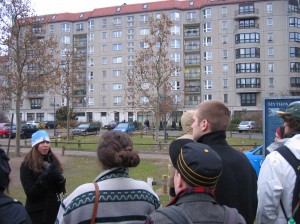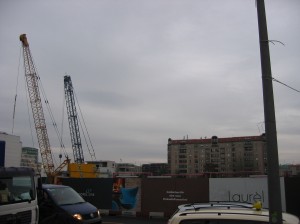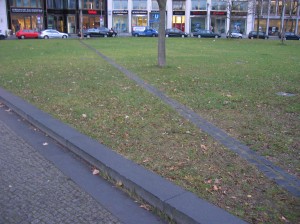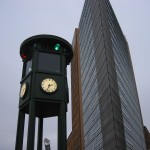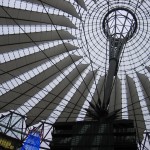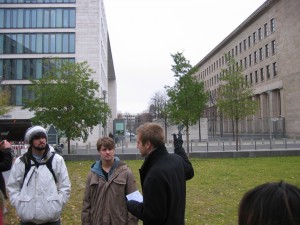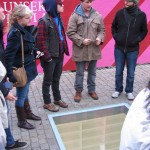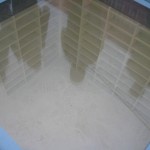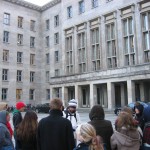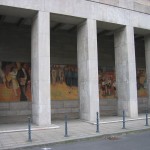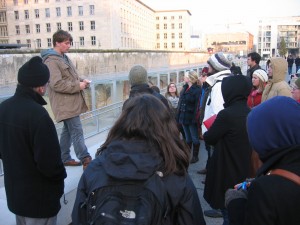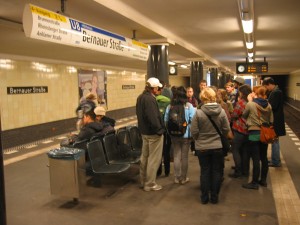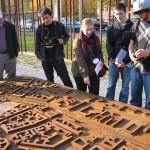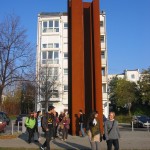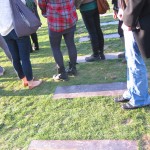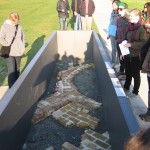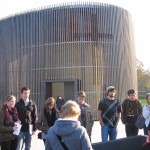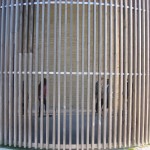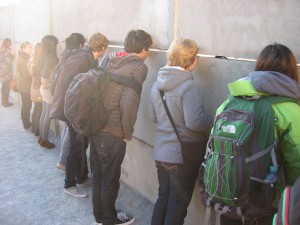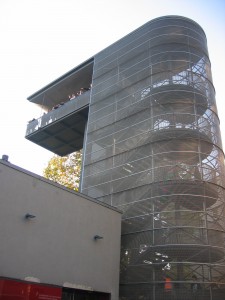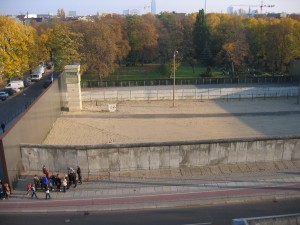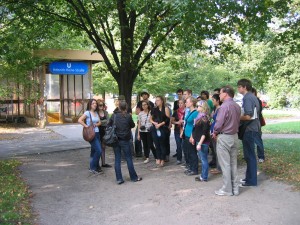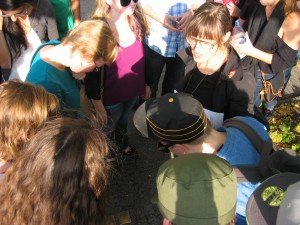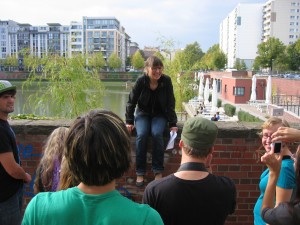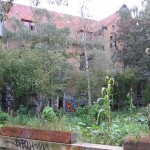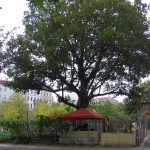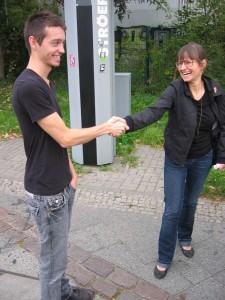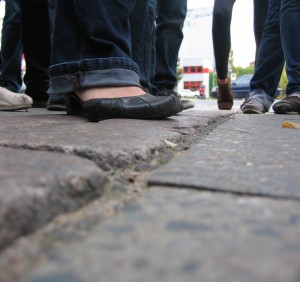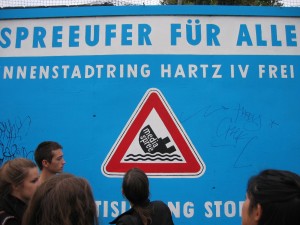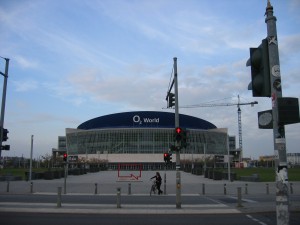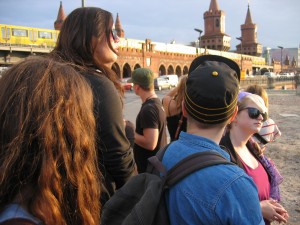A tour of Potsdamer Platz with Natalie & Ryna
Our final student-led walk took place this week, with a tour of Potsdamer Platz and its surroundings by Natalie and Ryna.
We started out at the former site of Hitler’s bunker – now hidden under a parking lot and GDR-era apartment buildings.
Our next stop was a huge construction site on Leipziger Platz, just half a block from Postdamer Platz. This plot was once home to Wertheim’s department store, headed by the pioneering and gifted businessman Georg Wertheim. Because he was Jewish, however, he was forced to leave the country in 1937, leaving his wife Ursula in charge of the company, which eventually folded and was re-established under different ownership after the war.
Now a new shopping center is being constructed on the site. Though it’s not owned by the Wertheim family, the idea is to refer to the strong commercial history of the area.
Also on Leipziger Platz, we viewed the brick strip that marks where the Berlin Wall once ran. It’s amazing to think that this whole area was a divided, empty wasteland just twenty years ago!
Potsdamer Platz is also strongly associated with certain technological breakthroughs – it became home to one of Europe’s very first traffic lights in 1924, and it is now also a center of the film industry in Berlin. The Sony Center (right) embodies this with its hi-tech roof design.
Moving from a booming commercial center in the twenties to bombed-out no-man’s-land during the mid-twentieth century, then back to thriving retail hub today, Potsdamer Platz is emblematic of the many recent and violent transformations of Berlin. It’s a fitting end to our student tours!
A tour of Nazi architecture in Mitte with Max, Klayton and Nick
Our theme for this week is the rebuilding of Berlin after the fall of the wall, and one of the things that architects, planners and politicians had to contend with was the history of totalitarianism that was still inscribed on the landscape. To deepen our understanding of this issue, our students Nick, Max and Klayton took us on a tour of sites in Mitte with Nazi history today.
The first stop on the tour was the Foreign Ministry, housed in the former Nazi Reichsbank (the browner building to the right). The first freely elected East German parliament also met here for a time in 1989-90, as they negotiated their integration with the West. In the early 1990s, a “Critical Reconstructionist” architect designed an addition (left). This is an approach, used throughout the center of the new Berlin, that seeks to integrate historical building traditions with modern design.
Next, we visited the memorial to the Nazi book burnings on Bebelplatz, right in front of the Humboldt University buildings.
The current Finance Ministry is housed in another interesting building with a layered history. Built to house the Nazi Air Ministry, it then became home to the GDR’s Council of Ministers after 1949. A socialist realist mural (right) was added at this time. The site is also known for its association with the workers’ uprising in 1953, and there is a memorial to this event on the grounds today.
Our last stop on the tour was the Topography of Terror, a site that contains the excavated remains of the Gestapo headquarters, as well as a museum dedicated to the history of Nazi-sponsored persecution. The Berlin Wall also ran along the edge of the site, as you can see above.
We’ll continue our exploration of Berlin’s responses to its own layered past next week, when we’ll be focusing on issues of memorialization.
A Tour of the Bernauer Strasse Wall Memorial with Libby, Roxana and Dominic
This week our students Libby, Roxana and Dominic took us on a tour of the Berlin Wall Memorial on Bernauer Strasse. We started the tour in the subway station, which during East German times had been a “ghost station” — because it lay in the East, it was a place that West German subways passed through but did not stop. Sometimes armed guards could be glimpsed in the darkened stations, but otherwise they were silent. Now they’ve been restored, and the U8 train stops at all the stations between Moritzplatz and Voltastrasse once more!
Emerging at street level, we entered the memorial site, which stretches for several blocks. The park encompasses what was formerly the ‘death strip’ – the space in between the two halves of the wall that divided East from West. Our tour guides directed us toward the many markers of structures that once existed on the site, including escape tunnels (right).
One of the most remarkable structures to have inhabited the death strip was an entire church, paradoxically named the Church of Reconciliation. It was demolished in the early 1980s by the East German government, but the foundations remain (left) and are now incorporated as relics in the park. A chapel has been built on the site to commemorate the many who died trying to escape over the wall.
Another portion of the park contains a reconstruction of the wall as it existed during East German times. This consists of a wall on the east side, then a large expanse of sand and barbed wire, and then finally another concrete wall on the west side. From the viewing tower that is part of the memorial museum (below), you can look down into this reconstructed portion.
Perhaps what is most amazing about this site is that it’s one of the only places in Berlin that you can tell there was ever a wall at all! The rest of the city has been so thoroughly sutured back together that you really have to hunt for the traces. This park preserves the memory of the terror that the wall once represented for Berlin’s citizens.
A walk through our Kiez with Manuela Mangold
Manuela Mangold, a long-time Kreuzberger, gave us a fantastic tour of the students’ “Kiez” in Berlin on Tuesday afternoon. Kiez is a local word meaning “neighborhood,” but it denotes not just a district of the city (in this case, Kreuzberg), but one’s immediate, local surroundings — the place where everyday life is lived.
We started our tour at the Heinrich-Heine-Strasse U-Bahn station, the stop where the students regularly get onto the subway. During the time when Berlin was divided, it was a border crossing used mainly for commercial traffic. Below, the subway station was a “ghost station” — because the wall ran in a zig-zag manner from roughly the southeast to the northwest, trains going from this part of West Berlin would pass under East Berlin on their way to other parts of West Berlin would pass through a completely darkened (and sometimes guarded) station.
Next on our tour was an example of Stolpersteine (“Stumble Stones”), an art project begun in Cologne, but which has left its mark all over Berlin. A form of Holocaust memorial, it marks where victims of the tragedy once lived. People are meant to “stumble” over these on their daily walks, a constant reminder of the importance of remembering the Holocaust, and its impact on life here.
We continued with a look at the path of the Berlin Wall and death strip. Manuela is sitting right between former East and West in the picture! As in most of Berlin, it’s been restored so nicely now that barely a trace of the division remains.
Oppositional culture has been a huge part of Kreuzberg’s identity since the 1970s. Here are two examples of “squatter” culture — both built right up against the Wall. One is a famous house squat, and the other a garden built right in the shadow of the wall, in what was technically East German territory!
We continued along the path of the wall, which is (in some places) marked by a strip of brick set into the ground. (Dominic represented East Germany, shaking hands with a West Berliner!)
Leaving our Kiez and crossing the Spree River, we continued on to talk about the politics of development along the river banks, another area where squatters and other oppositional movements have traditionally made their homes. Now big developers are buying up large swaths of property, driving up rents and bringing a whole new feel to the neighborhood, garnering vehement protest from locals. One glaring example of this is O2 World, a large concert venue whose undeniably corporate aura conflicts tangibly with its surroundings. Its VIP entrance along the river was heavily protested, but got built anyway.
We ended our tour at the Oberbaumbrücke, which was also divided by the Wall. Now, as you can see in the background, the U1 train line can run all the way across it again!
Our Kiez is in some ways the perfect spot for the students, sitting uncomfortably amidst the former East and West, scarred with layers of memory and history – and still transforming before our eyes.
tags
the author
I'm a doctoral student at CUNY Graduate Center. I'm thrilled to be teaching the CHID Berlin program with Prof. John Toews! You can contact me at naraelle [at] gmail.com, or find out more about me at www.naraelle.net.
Blogroll
- Annie Holden's blog
- Cassie Hoeprich's blog
- Dominic Barrera's blog
- Janet Williams's blog
- Mariah Alderete's blog
- Melissa Au's blog
- Robert Hampton's blog
- UW Students Study Abroad Our students Natalie and Cassie are contributing to the official IPE student blog this fall!



